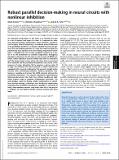Robust parallel decision-making in neural circuits with nonlinear inhibition
Author(s)
Kriener, Birgit; Chaudhuri, Rishidev; Fiete, Ila R
DownloadPublished version (4.916Mb)
Publisher Policy
Publisher Policy
Article is made available in accordance with the publisher's policy and may be subject to US copyright law. Please refer to the publisher's site for terms of use.
Terms of use
Metadata
Show full item recordAbstract
An elemental computation in the brain is to identify the best in a set of options and report its value. It is required for inference, decision-making, optimization, action selection, consensus, and foraging. Neural computing is considered powerful because of its parallelism; however, it is unclear whether neurons can perform this max-finding operation in a way that improves upon the prohibitively slow optimal serial max-finding computation (which takes ~N log(N) time for N noisy candidate options) by a factor of N, the benchmark for parallel computation. Biologically plausible architectures for this task are winner-take-all (WTA) networks, where individual neurons inhibit each other so only those with the largest input remain active. We show that conventional WTA networks fail the parallelism benchmark and, worse, in the presence of noise, altogether fail to produce a winner when N is large. We introduce the nWTA network, in which neurons are equipped with a second nonlinearity that prevents weakly active neurons from contributing inhibition. Without parameter finetuning or rescaling as N varies, the nWTA network achieves the parallelism benchmark. The network reproduces experimentally observed phenomena like Hick's law without needing an additional readout stage or adaptive N-dependent thresholds. Our work bridges scales by linking cellular nonlinearities to circuitlevel decision-making, establishes that distributed computation saturating the parallelism benchmark is possible in networks of noisy, finite-memory neurons, and shows that Hick's law may be a symptom of near-optimal parallel decision-making with noisy input.
Date issued
2020Department
Massachusetts Institute of Technology. Department of Brain and Cognitive Sciences; McGovern Institute for Brain Research at MITJournal
Proceedings of the National Academy of Sciences of the United States of America
Publisher
Proceedings of the National Academy of Sciences